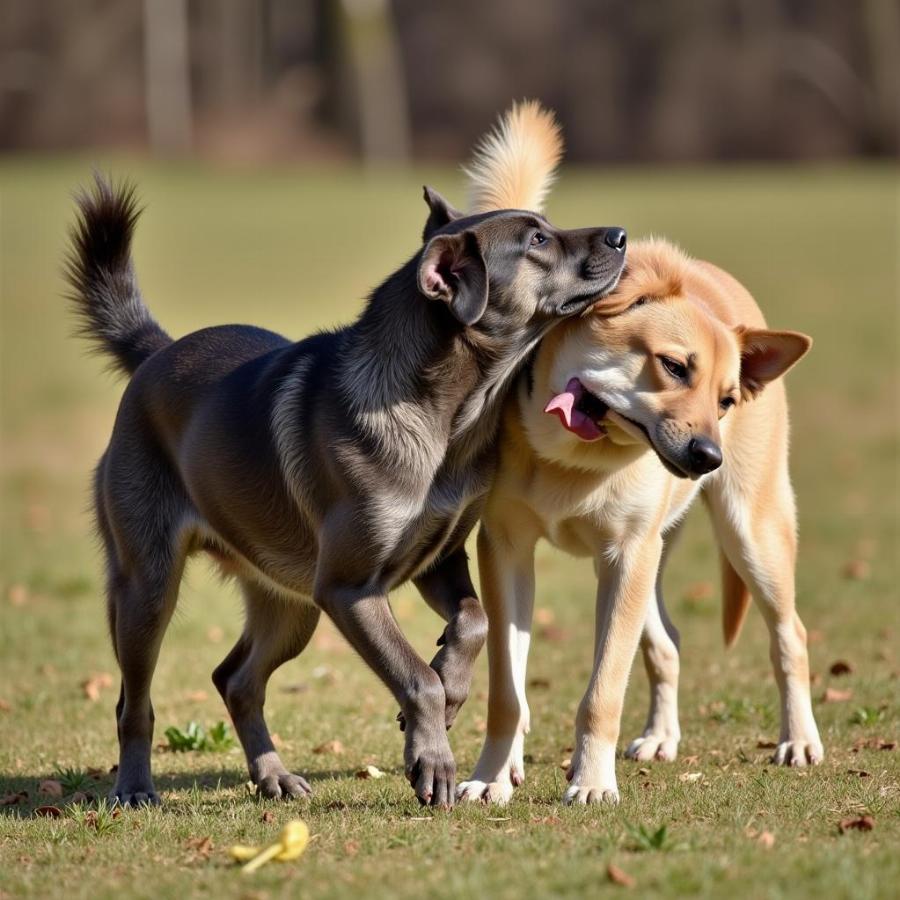After the “deed is done,” many owners wonder what changes they might observe in their male dog. Understanding the post-mating behavior of your canine companion is essential for responsible pet ownership. This article delves into the physical and behavioral changes you can anticipate in your male dog after mating.
Physical Changes in Your Male Dog After Mating
While the physical changes in a male dog post-mating aren’t as dramatic as those in a female, there are still some noticeable differences. The most obvious is the “tie,” or copulatory lock, where the male and female remain joined for a period, sometimes up to 30 minutes. This is a natural part of the mating process and shouldn’t be interrupted. Afterward, you might notice some swelling or redness around his genitals, which is usually temporary and resolves on its own.
What is the Tie During Mating?
The tie, often referred to as the dog knot comp, is a natural part of canine reproduction. During this time, the bulbus glandis, located at the base of the dog’s penis, engorges with blood, causing it to swell and lock inside the female’s vagina. This ensures that the sperm has a higher chance of reaching the eggs. It’s crucial to remember never to attempt to separate the dogs during this time as it can cause serious injury.
Behavioral Changes After Mating
Behavioral changes following mating can be subtle or more pronounced depending on the individual dog. Some males may exhibit increased affection towards their owner or become more protective of the female they mated with. Others might appear tired or less energetic for a short period following the mating process. Aggression is rarely a direct consequence of mating, but it’s important to monitor your dog for any unusual behavioral shifts.
Will My Dog Be More Affectionate After Mating?
While not all dogs will display increased affection, some might cling to their owners more or seek extra attention. This could be due to hormonal fluctuations or simply because the mating experience was physically and emotionally demanding. It’s important to provide your dog with a calm and comfortable environment during this time.
What if I Don’t Want Puppies?
If the mating was unplanned, several options are available. You can discuss the dog morning after pill with your veterinarian, though it’s essential to understand the risks and potential side effects. It’s also important to remember that prevention is the best course of action. Neutering your male dog can eliminate the risk of unwanted pregnancies and can also contribute to a calmer demeanor. Read more about the effects of neutering in our article do dogs calm down after being neutered.
Can Same-Sex Dogs Mate?
Yes, same-sex dogs can engage in mounting behavior, even though it won’t result in pregnancy. This behavior, often referred to as gay dog knotting, is usually related to dominance, play, or even just excitement. It’s a normal part of canine behavior and nothing to be concerned about.
 Two Male Dogs Interacting Playfully After Mating
Two Male Dogs Interacting Playfully After Mating
Signs a Male Dog Has Mated
While the “tie” is a clear indicator, other signs a male dog has mated can include licking his genitals excessively, appearing tired, or changes in appetite. It’s crucial to observe your dog for these signs, especially if you have an intact female.
Conclusion
Understanding the physical and behavioral changes you might observe in your male dog after mating is essential for responsible pet ownership. From the tie to subtle shifts in behavior, being informed allows you to provide the best possible care for your furry friend. If you have any concerns, consulting with a veterinarian is always recommended. Remember, responsible breeding practices and preventative measures, such as neutering, can prevent unwanted litters and contribute to the overall well-being of your canine companion.
FAQ:
-
How long does the tie last? The tie can last anywhere from a few minutes to up to 30 minutes.
-
Is it normal for my male dog to be tired after mating? Yes, mating can be physically demanding, so tiredness is a normal response.
-
Should I be concerned if my male dog is more aggressive after mating? While rare, changes in aggression should be discussed with a veterinarian.
-
How can I prevent my male dog from mating? Neutering is the most effective way to prevent mating.
-
What should I do if my dog mated with a dog I don’t know? Contact your veterinarian immediately to discuss options and potential health risks.
Have other questions? Consider exploring these related topics on our website:
- Canine reproduction
- Dog health and wellness
- Responsible pet ownership
Beaut Dogs is your trusted resource for all things related to dog ownership. We offer expert advice, insightful articles, and a wealth of information to help you navigate the joys and responsibilities of raising a canine companion. When you need support, please contact Email: [email protected] to have Beaut Dogs answer your questions in detail and accurately. Visit us at https://beautdogs.com today to discover more about the wonderful world of dogs!